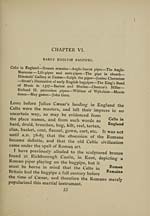Inglis Collection of printed music > Printed text > Story of the bagpipe
(58) Page 32
Download files
Complete book:
Individual page:
Thumbnail gallery: Grid view | List view

Story of the Bagpipe
the art ; the former, in consequence of intercourse and
affinity — strive with rival skill to emulate Ireland in
music . . . Wales employs and delights in three instru-
ments — the harp, the pipes, and the crwth."
In Morris's Welsh Collection, now in the British
Museum (Add. MSS. 14905), are several Irish airs,
including - the " Caniad Pibau Morwydd," or
Morris's „ The gong , of Morwydd - s pi pes ," a bagpipe
£ «, . melody. This collection is said to date from
the twelfth century (!), but it was not tran-
scribed till 1630, and a good part of it was written a
century later. 1
From the death of Llewellyn the Great in 1240 to the
annexation of Wales to England in 1283 there is very
little to chronicle of Welsh music, and it is only to our
purpose to add that the popularity of the bagpipe
practically disappeared at the opening of the fourteenth
century, the piob mor being replaced by the harp. The
only outlet for the bagpipe was for outdoor amuse-
ments, country dances, May-day games, etc. A rival
instrument of the same genus — namely, the pibconi,
was also coming into favour at this epoch, and
continued in use till the close of the eighteenth
century.
1 Miss Glyn's Evolution of Musical Form.
3 2
the art ; the former, in consequence of intercourse and
affinity — strive with rival skill to emulate Ireland in
music . . . Wales employs and delights in three instru-
ments — the harp, the pipes, and the crwth."
In Morris's Welsh Collection, now in the British
Museum (Add. MSS. 14905), are several Irish airs,
including - the " Caniad Pibau Morwydd," or
Morris's „ The gong , of Morwydd - s pi pes ," a bagpipe
£ «, . melody. This collection is said to date from
the twelfth century (!), but it was not tran-
scribed till 1630, and a good part of it was written a
century later. 1
From the death of Llewellyn the Great in 1240 to the
annexation of Wales to England in 1283 there is very
little to chronicle of Welsh music, and it is only to our
purpose to add that the popularity of the bagpipe
practically disappeared at the opening of the fourteenth
century, the piob mor being replaced by the harp. The
only outlet for the bagpipe was for outdoor amuse-
ments, country dances, May-day games, etc. A rival
instrument of the same genus — namely, the pibconi,
was also coming into favour at this epoch, and
continued in use till the close of the eighteenth
century.
1 Miss Glyn's Evolution of Musical Form.
3 2
Set display mode to: Large image | Transcription
Images and transcriptions on this page, including medium image downloads, may be used under the Creative Commons Attribution 4.0 International Licence unless otherwise stated. ![]()
| Special collections of printed music > Inglis Collection of printed music > Printed text > Story of the bagpipe > (58) Page 32 |
|---|
| Permanent URL | https://digital.nls.uk/94509872 |
|---|
| Description | Scottish and English songs, military music and keyboard music of the 18th and 19th centuries. These items are from the collection of Alexander Wood Inglis of Glencorse (1854 to 1929). Also includes a few manuscripts, some treatises and other books on the subject. |
|---|
| Description | The Glen Collection and the Inglis Collection represent mainly 18th and 19th century Scottish music, including Scottish songs. The collections of Berlioz and Verdi collected by bibliographer Cecil Hopkinson contain contemporary and later editions of the works of the two composers Berlioz and Verdi. |
|---|

